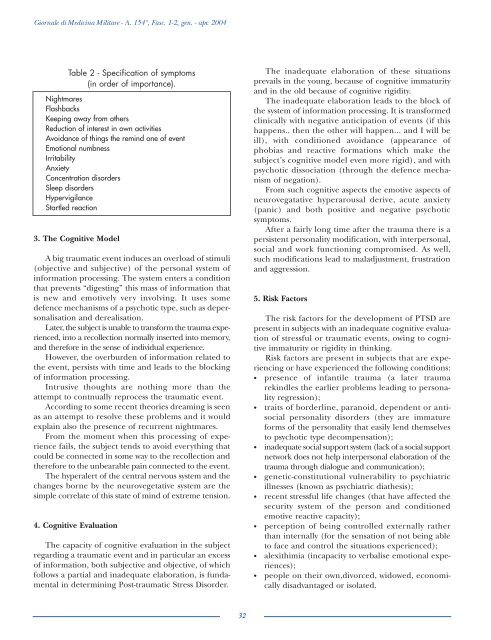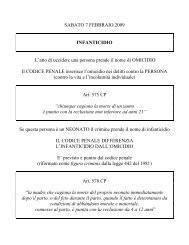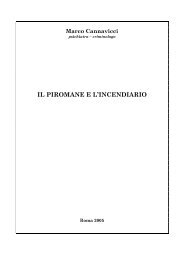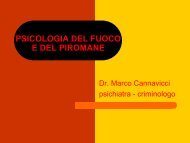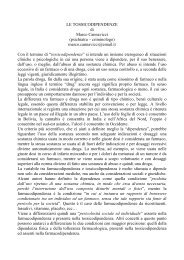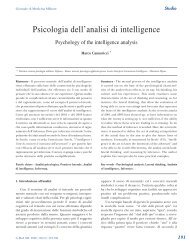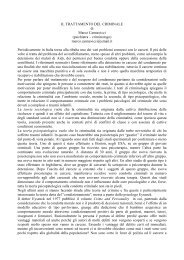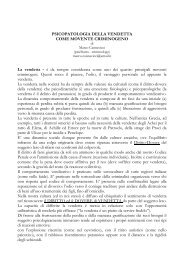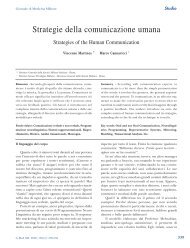Disturbo post-traumatico da stress: fattori di ... - Marco Cannavicci
Disturbo post-traumatico da stress: fattori di ... - Marco Cannavicci
Disturbo post-traumatico da stress: fattori di ... - Marco Cannavicci
You also want an ePaper? Increase the reach of your titles
YUMPU automatically turns print PDFs into web optimized ePapers that Google loves.
Giornale <strong>di</strong> Me<strong>di</strong>cina Militare - A. 154°, Fasc. 1-2, gen. - apr. 2004<br />
Table 2 - Specification of symptoms<br />
(in order of importance).<br />
Nightmares<br />
Flashbacks<br />
Keeping away from others<br />
Reduction of interest in own activities<br />
Avoi<strong>da</strong>nce of things the remind one of event<br />
Emotional numbness<br />
Irritability<br />
Anxiety<br />
Concentration <strong>di</strong>sorders<br />
Sleep <strong>di</strong>sorders<br />
Hypervigilance<br />
Startled reaction<br />
3. The Cognitive Model<br />
A big traumatic event induces an overload of stimuli<br />
(objective and subjective) of the personal system of<br />
information processing. The system enters a con<strong>di</strong>tion<br />
that prevents “<strong>di</strong>gesting” this mass of information that<br />
is new and emotively very involving. It uses some<br />
defence mechanisms of a psychotic type, such as depersonalisation<br />
and derealisation.<br />
Later, the subject is unable to transform the trauma experienced,<br />
into a recollection normally inserted into memory,<br />
and therefore in the sense of in<strong>di</strong>vidual experience.<br />
However, the overburden of information related to<br />
the event, persists with time and leads to the blocking<br />
of information processing.<br />
Intrusive thoughts are nothing more than the<br />
attempt to contnually reprocess the traumatic event.<br />
Accor<strong>di</strong>ng to some recent theories dreaming is seen<br />
as an attempt to resolve these problems and it would<br />
explain also the presence of recurrent nightmares.<br />
From the moment when this processing of experience<br />
fails, the subject tends to avoid everything that<br />
could be connected in some way to the recollection and<br />
therefore to the unbearable pain connected to the event.<br />
The hyperalert of the central nervous system and the<br />
changes borne by the neurovegetative system are the<br />
simple correlate of this state of mind of extreme tension.<br />
4. Cognitive Evaluation<br />
The capacity of cognitive evaluation in the subject<br />
regar<strong>di</strong>ng a traumatic event and in particular an excess<br />
of information, both subjective and objective, of which<br />
follows a partial and inadequate elaboration, is fun<strong>da</strong>mental<br />
in determining Post-traumatic Stress Disorder.<br />
32<br />
The inadequate elaboration of these situations<br />
prevails in the young, because of cognitive immaturity<br />
and in the old because of cognitive rigi<strong>di</strong>ty.<br />
The inadequate elaboration leads to the block of<br />
the system of information processing. It is transformed<br />
clinically with negative anticipation of events (if this<br />
happens.. then the other will happen... and I will be<br />
ill), with con<strong>di</strong>tioned avoi<strong>da</strong>nce (appearance of<br />
phobias and reactive formations which make the<br />
subject’s cognitive model even more rigid), and with<br />
psychotic <strong>di</strong>ssociation (through the defence mechanism<br />
of negation).<br />
From such cognitive aspects the emotive aspects of<br />
neurovegatative hyperarousal derive, acute anxiety<br />
(panic) and both positive and negative psychotic<br />
symptoms.<br />
After a fairly long time after the trauma there is a<br />
persistent personality mo<strong>di</strong>fication, with interpersonal,<br />
social and work functioning compromised. As well,<br />
such mo<strong>di</strong>fications lead to maladjustment, frustration<br />
and aggression.<br />
5. Risk Factors<br />
The risk factors for the development of PTSD are<br />
present in subjects with an inadequate cognitive evaluation<br />
of <strong>stress</strong>ful or traumatic events, owing to cognitive<br />
immaturity or rigi<strong>di</strong>ty in thinking.<br />
Risk factors are present in subjects that are experiencing<br />
or have experienced the following con<strong>di</strong>tions:<br />
• presence of infantile trauma (a later trauma<br />
rekindles the earlier problems lea<strong>di</strong>ng to personality<br />
regression);<br />
• traits of borderline, paranoid, dependent or antisocial<br />
personality <strong>di</strong>sorders (they are immature<br />
forms of the personality that easily lend themselves<br />
to psychotic type decompensation);<br />
• inadequate social support system (lack of a social support<br />
network does not help interpersonal elaboration of the<br />
trauma through <strong>di</strong>alogue and communication);<br />
• genetic-constitutional vulnerability to psychiatric<br />
illnesses (known as psychiatric <strong>di</strong>athesis);<br />
• recent <strong>stress</strong>ful life changes (that have affected the<br />
security system of the person and con<strong>di</strong>tioned<br />
emotive reactive capacity);<br />
• perception of being controlled externally rather<br />
than internally (for the sensation of not being able<br />
to face and control the situations experienced);<br />
• alexithimia (incapacity to verbalise emotional experiences);<br />
• people on their own,<strong>di</strong>vorced, widowed, economically<br />
<strong>di</strong>sadvantaged or isolated.


